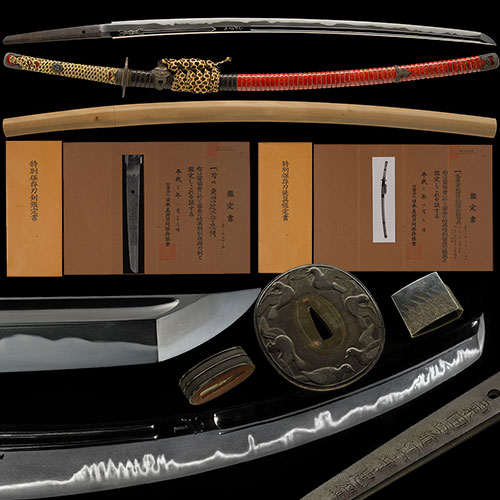
粟田口近江守忠綱 刀Awataguchi Ouminokami Tadatsuna Katana
No.566308刀 粟田口近江守忠綱 亀甲唐草繋文刻鞘太刀拵付 内外重要候補 互の目丁子傑作 二尺四寸二分Katana Awataguchi Ouminokami Tadatsuna KikkouKarakusa tsunagimonkizamisaya Tachigoshirae-tsuki Naigai(inside and outside) Juyo candidate Gunome-Chouji a masterpiece 73.3cm
ご成約Sold
- 銘表Mei-Omote
- 粟田口近江守忠綱 彫物同作 粟田口近江守忠綱 彫物同作 Awataguchi Ouminokami Tadatsuna Horimono-dousaku(Engraving same work)
- 登録証Registration
- 埼玉県 Saitama 昭和27年10月17日 10/17/27(Showa)
- 時代Period
- 江戸前期Early Edo Period
- 法量Size
-
刃長 73.3cm (二尺四寸二分) 反り 1.8cm
元幅 3.3cm 先幅 2.2cm 元重 0.75cm 鎬厚 0.75cm 先重 0.50cm 鋒長 3.2cm 茎長 21.0cm 重量 775gHachou 73.3cm (二尺四寸二分) Sori 1.8cm
Moto-Haba 3.3cm Saki-Haba 2.2cm Moto-Kasane 0.75cm Shinogi-Thikess 0.75cm Saki-Kasane 0.50cm Kissaki-Chou 3.2cm Nakago-Chou 21.0cm Weight 775g - 国Country
- 摂津Settsu
- 姿Shape
- 鎬造、庵棟、身幅広く、反り深く、中鋒やや延びる。Shinogidukuri, Iorimune, Wide Mihaba, Deep Sori, Chu-Kissaki slightly extended.
- 鍛Kitae
- 小板目肌つみ、板目・杢目肌交じり、地沸厚くつき、地景よく入り、鉄明るく冴える。Small-Itamehada-tsumi, Mixed Itame and Mokume-hada, Jinie entered thick, Chikei often, Iron is bright and clear.
- 刃文Hamon
- 直ぐ調に焼き出し、互の目乱れに、丁子交じり、足太くよく入り、小沸深くよくつき、金筋長く頻りにかかり、匂口明るく冴える。Sugu-style Yakidashi, Gunome-Midare, Mixed Choujil, There are many Ashi thickly, Small-Nie entered deeply, Long Kinsuji shikirini-kakari, Nioikuchi is bright and clear.
- 帽子Boushi
- 直ぐに小丸、深く返る。Suguni-komaru ,Fukaku-kaeru
- 茎Nakago
- 茎は生ぶ、先刃上り栗尻、鑢目筋違、目釘孔一。Ubu Nakago, Sakiha-agari-Kurijiri, Yasurimesujikai, Mekugiana is 1.
- ハバキHabaki
- ハバキは銀着一重。Habaki Silver-clad single layer
- 拵Sword mounitings
- 亀甲唐草繋紋散腰石目地朱塗印籠刻鞘太刀拵[江戸時代]
日本美術刀剣保存協会 特別保存刀装具
法量 長さ113.7cm 反り5.1cm
説明
総金具 赤銅魚子地
目貫 赤銅高彫鳩丸図
鐔 鉄地素文 多切羽 四分一鳩図高彫。Kikkou Karakusa Tsunagimonchirashi Koshiishimeji Syunuri Inrou kizamisaya TachiKoshirae [Edo era]
Nihon Bijutsu Token Hozon Kyokai
Tokubetsuhozon Tousougu
Size
Length 113.7cm
Sori 5.1cm
Description
Total metal fittings Syakudounanakoji
Menuki Syakudou Takabori Hatomaruzu
Tsuba Tetsujisobun Taseppa Shibuichi Hatozu Takabori - 彫物Carving
- 表腰に三鈷剣に梵字、先に棒樋丸止、添樋、裏腰爪に二筋樋、梵字に先棒樋丸止、添樋を彫る。Omotegoshi Sanjoken-Bonji Sakini-Bouhi-Marudome, Soebi, Uragoshidume-Futasujihi, Bonji-Sakibouhi-Marudome, Soebi-carving
- 説明Drscription
- 二代忠綱は、名を浅井万太夫といい、初代近江守忠綱の子で、初銘を忠国という。現存する年紀作は寛文十二年から享保十二年の55年間に渡る。延宝頃に二代目を継ぎ近江守を受領、元禄二年頃から一竿子と号した。助広・真改と共に大阪の三英傑と賞されて誉れ高い。作風は、その初期においては、初代同様の焼頭が揃った足の長い丁子乱れが多く、後には、互の目乱れや涛瀾風の乱れ、直刃・浅いのたれなどを焼いている。竜・倶利伽羅・梅倶利伽羅・三鈷剣などの彫物の名手としても知られている。この刀は、小板目肌に地沸厚く付き、地景よく入る美しい地鉄に、互の目乱れに、丁子交じり、足太くよく入り、華やかに乱れ、小沸深くよく付き、金筋長く頻りに入るなど働き豊かで、地刃明るく冴える傑作である。三鈷剣に梵字の彫も見事な出来である。付帯する時代の太刀拵は、亀甲唐草繋文の刻鞘に鳩図一作で作られた赤銅の金具が付く見事なもので、割れや傷も無く保存状態が頗る良い。内外とも重要候補の名品である。The second Tadatsuna, whose name was Mandayu Asai, was the son of the first Omi no kami Tadatsuna, and was originally named Tadakuni. The extant chronological works span the 55 years from the 12th year of Kanbun to the 12th year of Kyoho.
He took over Ouminokami around Enpo as the second generation and took the name Ikkanshi around Genroku 2nd year.Along with Sukehiro and Shinkai, he was honored as one of Osaka's three heroes.
In the early days of his work, many of his styles were Long Ashi and Long Chouji-Midare, Afterwards, Gunome-Midare and Touran-style Midare, Suguha and Shallow Notare-yaki.He is also known as a master carver of dragons, Kurikara, plum Kurikara, Sankoken(sword), etc.
This sword has a thick Jinie and Small-Itame-hada, Chikei entered well in beautiful Jitetsu, Gunome-Midare, Mixed Chouji, Ashi entered thick and well. Gorgeous Midare, Small-Nie entered deeply, It is rich in work, such as entering Long Kinsuji frequently. Jiba is bright and clear masterpiece.The carving of Sanskrit characters on Sankoken is also excellent.Tachi-Koshirae of the attached era is a wonderful KizamiSaya of KikkouKarakusa Tsunagimon with red copper metal fittings made by Hatozu. It is in excellent condition with no cracks or scratches. Both inside and outside, it is a masterpiece of Juyo candidate.



 日本語
日本語 ENGLISH
ENGLISH